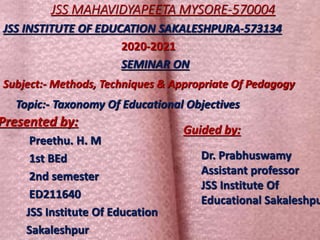
Taxonomy of Educational objectives
- 1. JSS MAHAVIDYAPEETA MYSORE-570004 Presented by: Preethu. H. M 1st BEd 2nd semester ED211640 JSS Institute Of Education Sakaleshpur JSS INSTITUTE OF EDUCATION SAKALESHPURA-573134 2020-2021 SEMINAR ON Subject:- Methods, Techniques & Appropriate Of Pedagogy Topic:- Taxonomy Of Educational Objectives Guided by: Dr. Prabhuswamy Assistant professor JSS Institute Of Educational Sakaleshpu
- 2. Content: • Overview of 1. Taxonomy 2. Educational Objectives • Definition • Classification of domains 1. Cognitive 2. Affective 3. Psychomotor • Sub division of three domains • Conclusion • Reference
- 3. Overview Taxonomy • It means, it is a hierarchical model that describes, 1. Classification. . 2. Sequencing procedures • The word taxonomy comes from the Greek word taxis= arrangements & nomos= science • i.e. Science of arrangements
- 4. Educational Objectives • It depict what students should be able to do at the end of a learning activity • As educational Objectives are more focused on the learning performance,it is also called as "learning Objectives" • According to Sir JJ Guilbert, " Objectives refers to the results sought by the learner at the end of the educational programme i.e. what the students should be able to do at the end of a learning period, that they could not do before hand."
- 5. • Taxonomy of Educational Objectives was developed by the Benjamin Bloom of the university of Chicago in 1956 with the help of several educational measurement specialist • It is also called as the Bloom taxonomy of Educational Objectives • Definition • Bloom's taxonomy is a classification system used to define and distinguish different levels of human cognition-i.e., thinking, learning,and understanding.
- 7. Cognitive objective • Benjamin Bloom(1956) Affective Objective • Krath Whol,Bloom& Maria (1964) Psychomotor Objective • Simpson (1966), Harrow (1972)
- 8. Cognitive Domain Affective Domain Psychomotor Domain Knowledge Receiving Perception Comprehensive Responding Set Application Valuing Guided Response Analysis Organization Mechanism Synthesis Characterization Complex overt response Evaluation
- 10. Cognitive Domain • Taxonomy related to cognitive domain,has been presented by Bloom & his associates in 1956 • This domain includes those objectives which deals with thinking, reasoning ability and problem solving of students. • This domain further divided in six categories.
- 11. • Lowest level of objectives • Primarily aims for the acquisition of knowledge concerning facts, terminology • Methods & precesses, generalized principles, theories & structures • Based upon the knowledge • If there is no knowledge, there will be no comprehension • It means basic understanding of facts, ideas, methods, process, principles or theories 1. KNOWLEDGE 2.COMPREHENSION(UNDERSTANDING)
- 13. • Involves the"putting together of elements &parts so as to form a whole." • Student originates, integrates, & combines ideas into a product, plan or proposal that is new to him. • He can create, design, invent & develop • He can combine different types of information to find alternative solutions • Example: he can combine this to make a sentence: • Mother-invention-is-necessary-the • Judgements about the value of material & methods for given purposes. • Student can judge what he learned whether it is right or wrong. If wrong than he can start the process again. • Student can judge, recommend, critique & justify. 6.EVALUATION 5. SYNTHESIS
- 14. Affective Domain • The affective domain includes those objectives which deals with attitude, values, interest & appreciation. • These objectives of affective domain is divided into five major classes of objectives.
- 15. • The lowest level; the student passively pays attention. Without this level, no learning can occur. Receiving is about the student's memory & recognition as well. • Example: student saw a person helping poor... • The student actively participates in the learning process, not only attends to a stimulus; the student also react in some way. • Example: He saw that people appreciating the person who helped poor... 1.RECEIVING 2.RESPONDING
- 16. • The student attaches a value to an object, phenomenon,or piece of information. The student associates a value or some values to the knowledge they acquired. • Example: He gives values that helping poor is an appreciable work... • The student can put together different values, information & ideas & can accommodate them within his/her own scheme;the student is comparing, relating & elaborating on what has been learned. • Example: Than he organizes his learning that how he can help poor.. 3.VALUING 4. ORGANIZING
- 17. • The student at this level tries to build abstract knowledge. • Example: At this Stage the habit becomes the part of his character. 5.CHARACTARIZING
- 18. Psychomotor Domain • This domain includes those objectives which deals with manual and motor skills. • This domain also divided in five categories.
- 19. • Lowest level in Psychomotor Domain • Primarily determined with activities relating to senses • Acquired through experience & systematic training • Initial adjustment which occur for specific activities & experiences related with • Mental • Physical • Emotional 1. PERCEPTION 2. SET
- 20. • Initial stage of developing 1. A practical skill 2. External behavior • Of a leaner under guidance of another person 3. GUIDED RESPONSE
- 21. • At this level development of 1. Self confidence 2. Skill for doing some task • High level of Psychomotor Domain • Learner acquires so much efficiency & skills that accomplish the most complex task with minimum energy & time 4.MECHANISM 5. COMPLEX OVERT RESPONSE
- 22. Conclusion • Bloom's Taxonomy is simply a classification system for educational goals that tie in to the level of student comprehension that is necessary for achievement or mastery. • Bloom's Taxonomy helpful for a teacher in making his teaching learning process effective
- 23. Reference • http://www.researchgate.net • http://www.slideshare.net • http://educerecentre.com
- 24. Thank you